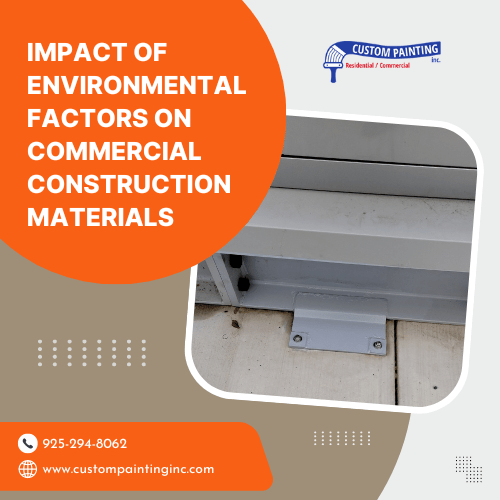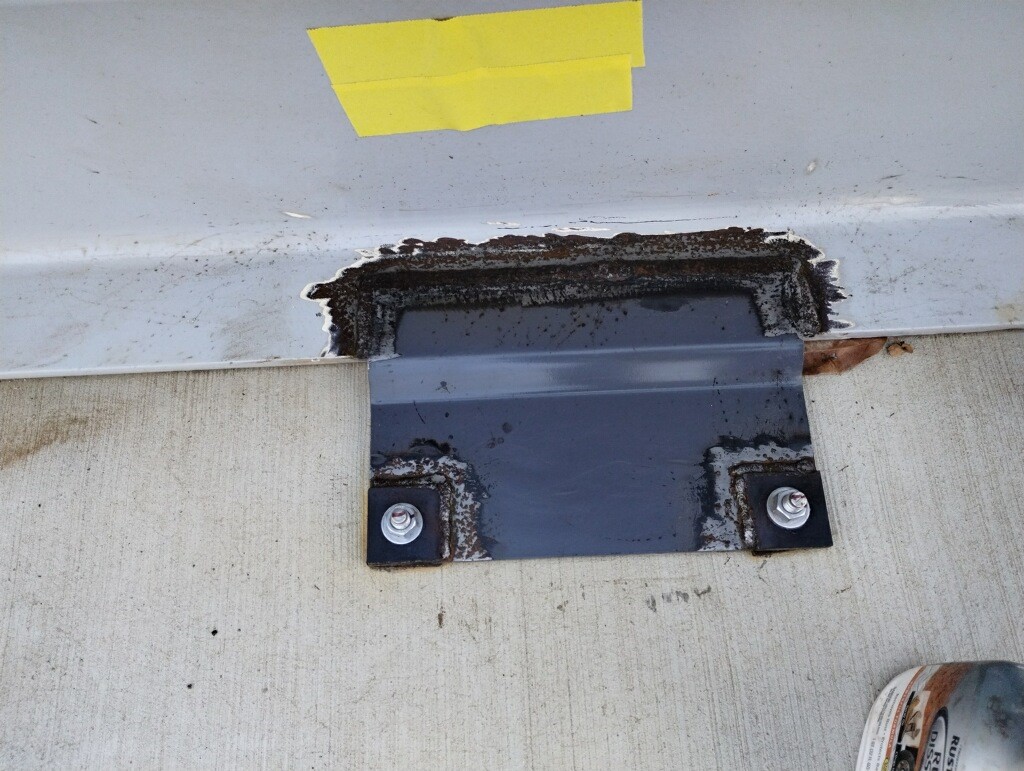Custom Painting, Inc. recently finished painting 76 brackets in Milpitas, CA. It is a common type of task that the company tackles a few times a year, making it reliable for this type of painting job. Throughout the whole project, the only challenge that the team faced was the weather due to the frequent rain. That’s why they set a 4-day window to complete the work properly. Luckily, the team finished the project well, which was a success.
Why do you need to paint brackets or other construction materials with this? The materials we choose in commercial construction lay the foundation for structural integrity, long-term sustainability, and efficiency. However, these materials face relentless environmental challenges, including weather extremes, moisture, and pollution.
In this article, we will explore the profound impact of environmental factors on commercial construction materials, highlighting the essential roles of these materials, the risks they face, and how strategic painting can shield them from damage. We will also discuss the best practices for maintaining and protecting these critical assets to ensure the longevity and resilience of commercial structures.
Roles of Commercial Construction Materials
In the vast and complex world of commercial construction, many materials play pivotal roles in building functional, sustainable, and aesthetically pleasing structures. From the towering steel frames of skyscrapers to the concrete foundations that anchor them to the earth, each material is selected for its unique properties and role in the overall design.
Key Materials and Their Functions
- Steel: Renowned for its strength and durability, steel is a cornerstone of modern construction. It provides the skeletal framework for most commercial buildings, offering the high tensile strength needed to support immense weights and withstand external forces.
- Concrete: Another fundamental material, concrete, is the primary substance for foundations, floors, walls, and beams. Its versatility and strength make it indispensable, especially in creating structures that must endure over time against various stresses.
- Wood: While less common in high-rise construction, wood is still vital in commercial construction, particularly in framing for smaller buildings and interior features and as an aesthetic choice for facades and finishes.
Specialized Components: The Role of Brackets
Beyond these primary materials, specialized components such as brackets play critical roles in the integrity and functionality of commercial buildings. Brackets, often made of steel or heavy-duty alloys, are used to:
- Support and Stabilize: They reinforce connections between structural elements, ensuring stability and resistance to stress and movement.
- Aesthetic Purposes: Architectural brackets can add visual interest and detail to building exteriors, blending structural integrity with design elegance.
- Utility Attachments: Brackets are also essential for attaching utilities and external features like signage, lighting, and decorative elements, seamlessly integrating them into the building’s architecture.
The Importance of Durability and Sustainability
Choosing the right materials goes beyond immediate architectural needs. Durability and sustainability are paramount, ensuring that buildings not only last but do so in a way that minimizes their environmental footprint. This involves:
- Selecting Materials with Long Lifespans: To reduce the need for frequent replacements and maintenance.
- Considering Environmental Impact: Opting for materials that are sustainably sourced and manufactured and reducing the construction industry’s overall ecological footprint.
- Innovative Use of Materials: Exploring new ways to use traditional materials for better efficiency and environmental compatibility.
From the steel that frames our cities’ skylines to the brackets that hold together the intricate details, each material is selected to meet the dual demands of form and function, ensuring that our built environment stands the test of time while respecting the natural world.
Environmental Factors Affecting Construction Materials
Understanding the Environmental Challenges
The materials used in commercial construction are continuously exposed to various environmental conditions that can significantly affect their longevity and performance. Understanding these factors is crucial for selecting materials that can withstand such challenges over time. Here are the primary environmental factors that impact construction materials:
- Temperature Fluctuations: Extreme temperature changes can cause materials to expand and contract, leading to structural fatigue, cracks, and other deterioration. This cyclical stress is particularly damaging to materials like concrete and can affect the integrity of steel structures.
- Moisture and Humidity: Water is one of the most significant threats to construction materials. Moisture can lead to metal corrosion, wood rot, and mold proliferation in various materials. Humidity can exacerbate these issues, speeding up the degradation process.
- UV Radiation: Ultraviolet (UV) rays from the sun can weaken and degrade various materials over time. For instance, prolonged UV exposure can fade and crack paint, reduce the elasticity of roofing materials, and even deteriorate plastics and certain types of rubber.
- Chemical Exposure: Many construction materials are susceptible to damage from chemical exposure. This can include pollutants in the air, acidic rain, and chemicals in the surrounding soil. Such exposure can corrode metals and weaken other materials like concrete and wood.
Mitigating the Impact
To ensure the longevity and durability of construction materials, it’s essential to consider these environmental factors from the design phase through to maintenance. Here are some strategies to mitigate the impact:
- Material Selection: Choosing materials that are naturally resistant to environmental stresses. For example, stainless or galvanized steel can help prevent corrosion, while treated wood can resist moisture and rot.
- Protective Coatings: Protective coatings can shield materials from moisture, UV radiation, and chemical exposure. Paints, sealants, and other coatings are designed to prolong the life of construction materials.
- Design Considerations: Incorporating design elements that minimize environmental exposure can also protect materials. Overhangs, for example, can shield walls from rain, while proper site drainage can prevent water from pooling and causing damage.
- Regular Maintenance: Routine inspections and maintenance are vital for identifying and addressing environmental damage before it becomes severe. This includes cleaning, repainting, sealing, and replacing damaged components as necessary.
Environmental factors pose a significant risk to the integrity and longevity of commercial construction materials. By understanding these challenges and implementing strategies to mitigate their impact, construction professionals can ensure that their projects remain safe, sustainable, and durable for years to come.
Protective Measures and Maintenance
Regular maintenance is the linchpin in prolonging the lifespan of construction materials and ensuring the structural integrity and aesthetic appeal of commercial buildings. Maintenance strategies vary according to the material type, environmental exposure, and the specific application within the structure. The goal is to identify and address potential issues before they escalate into significant problems, thereby extending the life of the materials and maintaining the building’s overall health.
Painting as a Primary Protective Measure
One of the most effective ways to protect construction materials from environmental damage is through painting. Paint serves an aesthetic purpose and is a vital barrier protecting materials from moisture, UV rays, chemical pollutants, and other environmental factors.
- Moisture Resistance: A proper coat of paint can seal the surface of materials, preventing water penetration that can lead to corrosion, rot, and mold growth.
- UV Protection: Paints with UV inhibitors can reflect or absorb harmful UV rays, reducing the rate at which materials degrade under sunlight.
- Chemical Resistance: Specialized coatings can provide a barrier against airborne chemicals and pollutants, protecting the material’s surface from corrosion and deterioration.
Best Practices for Painting and Maintenance
To maximize the protective benefits of painting and ensure effective maintenance, it’s crucial to follow best practices tailored to the specific needs of commercial construction materials.
- Surface Preparation: The key to effective painting lies in proper surface preparation, which may include cleaning, sanding, and applying a primer. This ensures that the paint adheres well and provides a uniform protective layer.
- Choosing the Right Paint: Selecting the appropriate type of paint for each material is critical. Factors to consider include the material’s characteristics, the environmental conditions it will face, and the desired aesthetic outcome. For example, latex-based paints are often preferred for their flexibility and durability, while oil-based paints may be chosen for their resistance to wear and moisture.
- Application Techniques: Employing the right application techniques ensures even coverage and optimal protection. This might involve using brushes, rollers, or sprayers, depending on the surface area and the type of paint used.
- Regular Inspections and Touch-Ups: Routine inspections can identify areas where the paint has chipped, cracked, or degraded, allowing for timely touch-ups. This prevents water and other damaging agents from penetrating the protective barrier and affecting the underlying material.
- Scheduled Repainting: Even the best paint will degrade and lose its protective qualities over time. Scheduling regular repainting, based on the paint’s expected lifespan and the material’s exposure to environmental stressors, is essential for continuous protection.
In essence, a comprehensive approach to maintenance, with a particular focus on painting, can significantly mitigate the environmental impact on commercial construction materials. By adhering to best practices for surface preparation, paint selection, and application, construction professionals can safeguard the longevity and integrity of their projects, ensuring that they withstand the test of time and the elements.
Conclusion
The environmental factors that impact commercial construction materials are significant and varied, posing challenges to durability and integrity. Understanding these factors, alongside the pivotal roles of such materials, is crucial in navigating their effects. Protective measures, especially painting, are essential for safeguarding materials against environmental threats.
By incorporating thorough maintenance routines and adhering to best practices in painting, we can extend the life of these materials, ensuring the sustainability and resilience of commercial structures. This comprehensive approach enhances the longevity of construction projects and contributes to a more sustainable and efficient construction industry.
Ready to give your commercial construction materials the protection they deserve? At Custom Painting, Inc., we provide top-quality painting services designed to shield your materials, like brackets, from the harsh realities of environmental exposure. Whether it’s combating moisture, UV rays, or wear and tear, our expert team is here to help.
Don’t let the elements take a toll on your construction materials any longer. Call us today at 510-795-0903 to discuss your project and discover how we can extend the life of your materials with our professional painting services. Would you prefer to reach out online? No problem! Fill out our online contact form, and we’ll get back to you promptly to address your needs. Protect your investment with Custom Painting, Inc. – where quality and durability meet.




